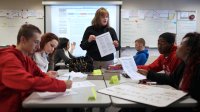Modeling Writing and Revising for Students
A high school history teacher demonstrates the writing process for students by composing and editing an article while they observe.
Your content has been saved!
Go to My Saved Content.“If I had had more time, I would have written a shorter letter.”
I share this adage—which may have originated with Blaise Pascal—with my high school history students before launching a unit on clear, concise writing. I tell them that as juniors they must omit unneeded words while crafting precise, economical prose.
This isn’t a simple task—most students consider an assignment complete as soon as they write the final sentence. I’m not alone in noting that many high schoolers neglect to revise their writing, resulting in disappointing grades and frustration on all sides. Fortunately, I’ve also experienced success with modeling effective writing, which is critical to helping teenagers develop essential revision skills.
Starting With Small Steps
Before introducing longer writing assignments, early in the year I ask students to respond to short-answer questions about the summer reading. They complete these during class, as I want a clear picture of what they can do without outside assistance. Afterward, I share some of the responses—anonymously—to highlight mistakes of various kinds, including errors in punctuation and grammar, logical fallacies, and generalizations.
As students discuss these oversights, I ask them not to point fingers at suspected authors. “What’s important is that you learn from these mistakes, not focus on trying to find out who made them,” I say, adding that nobody, including their teacher, is beyond benefiting from criticism. To drive this point home, I share drafts of articles I write with my students—including this one—including comments from the editors I work with.
Modeling Writing
To encourage students to think deeply about their writing, I share with them my favorite passage from William Strunk Jr. and E.B. White’s The Elements of Style, one of my preferred writing guides: “A sentence should contain no unnecessary words, a paragraph no unnecessary sentences, for the same reason that a drawing should have no unnecessary lines and a machine no unnecessary parts. This requires not that the writer make all sentences short, or avoid all detail and treat subjects only in outline, but that every word tell.” I also encourage students to embrace clarity.
To practice applying this advice, students each write a 700-word opinion article about Thomas Jefferson’s legacy in American history. I give around two weeks to complete this assignment, which affords ample time for students to hone their work, as well as meet with me if they’re struggling.
Before I send students on their way, however, I take 25 minutes to compose my own response, which I project so students can watch me write. I model laboring over writing a perfect first sentence (the lede), constructing effective transitions, and selecting sharp diction. As I write, students also see how I constantly refine my work, moving often between paragraphs to tweak structure and narrative flow. Meanwhile, I field questions about my thought process, such as why I have decided to tweak a clause or reconsider my syntax.
I also encourage students to call me out on whatever mistakes I might make, from content-related issues to writing style. I sometimes purposefully make mistakes to ensure that students are paying attention, and I’m happy when students spot something I didn’t mean to write that needs addressing.
To deter students from feeling deflated by my productivity—especially as I suspect it will take them several hours to complete this task—I remind them that I’ve had much longer to think about their assignment and that I’ve been teaching these skills for a dozen years.
Modeling Editing
When it’s time for a first submission, I avoid using the word draft, which signals to students the permissibility of submitting unfinished work, or work rife with problems. Instead, I encourage students to give the first completed version their all, explaining that otherwise I’ll be unable to help them achieve their full potential on the assignment.
After students submit their first completed versions of the Jefferson assignment, I project anonymous paragraphs—or grafs, as journalists concisely call them—with a word processor. Keeping clarity in mind, students revise passages like these, provided verbatim:
- Jefferson, President Jefferson, gave the Natives options, the following…..to follow this white civilization, or to get the removal and kicked out the of tribal territory.
- On the other hand, critics toward Jefferson never stops. He called for liberty yet owned over 600 slaves. It is quite concerning for the American citizens that the 7th best president didn’t even obey what himself proposed.
- Just recently, CBS published an article ranking Thomas Jefferson as number 7 for the nation’s best president. Thomas Jefferson was a morally corrupt hypocrite that constantly contradicted his own words. Thomas Jefferson’s ranking is completely absurd and needs to be lowered.
As we edit this work together, students appreciate how revision, though at times laborious, pays off. As a class, they may also discuss several other examples before breaking into smaller groups to suggest revisions in a more intimate setting. By helping each other improve, students also improve at noticing their own mistakes, and that’s the ultimate goal.
In this case, I was so proud of the students’ final versions of the Jefferson assignment that I posted several of them online, including work by the authors of the examples above.
